
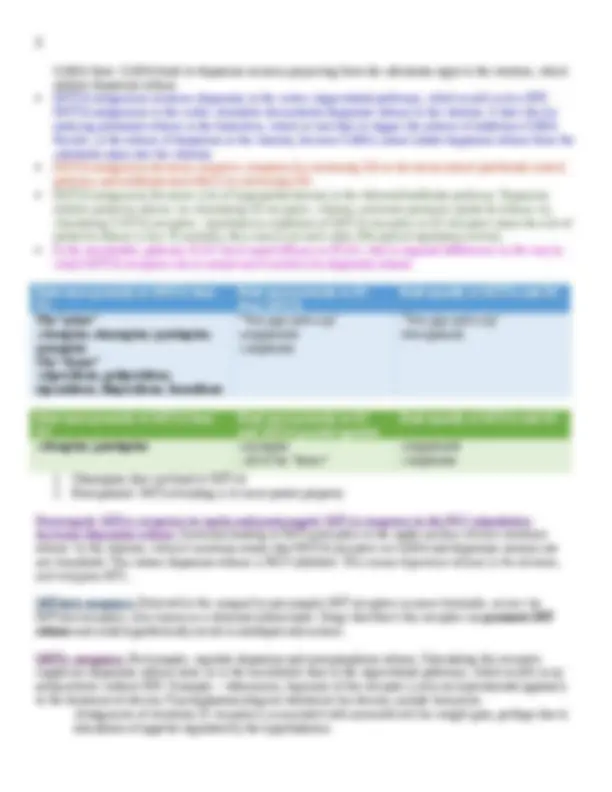


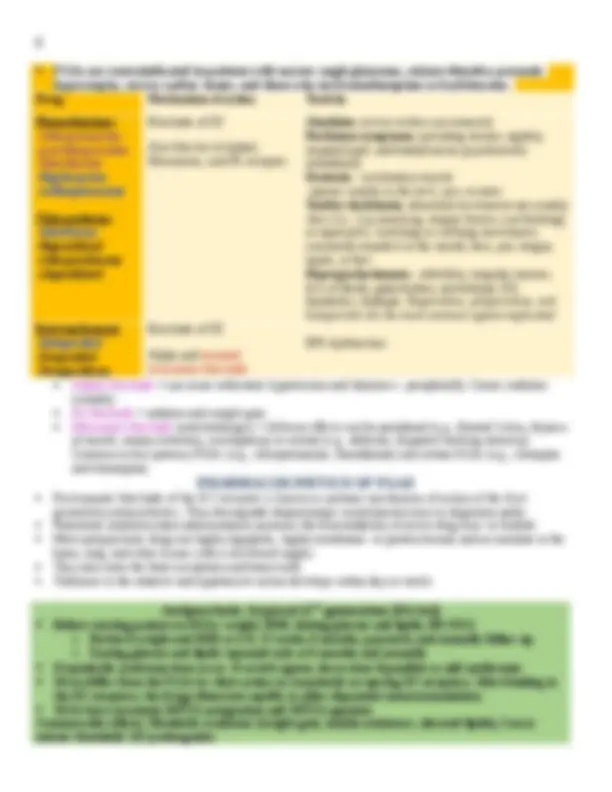
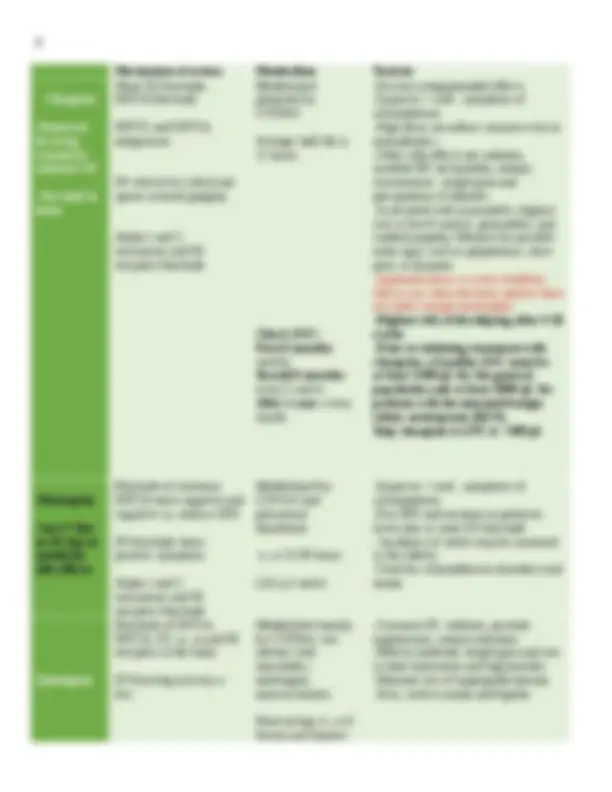
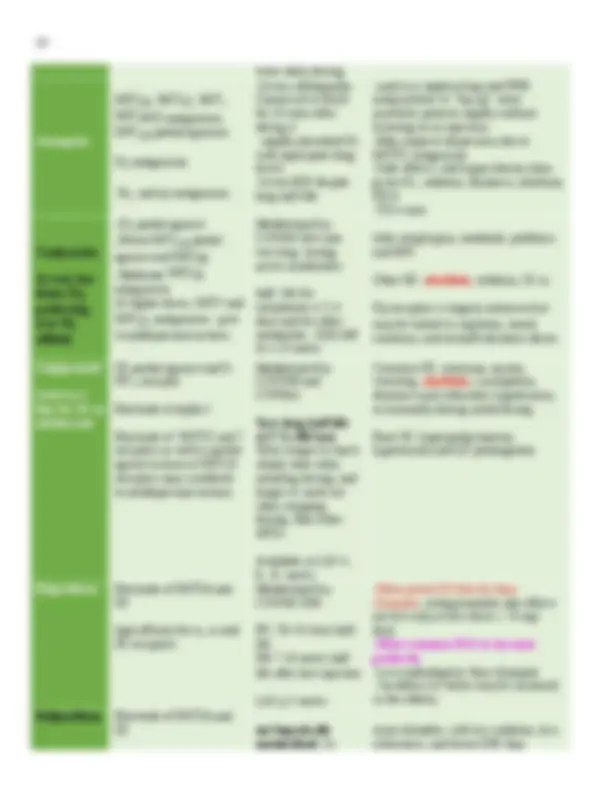
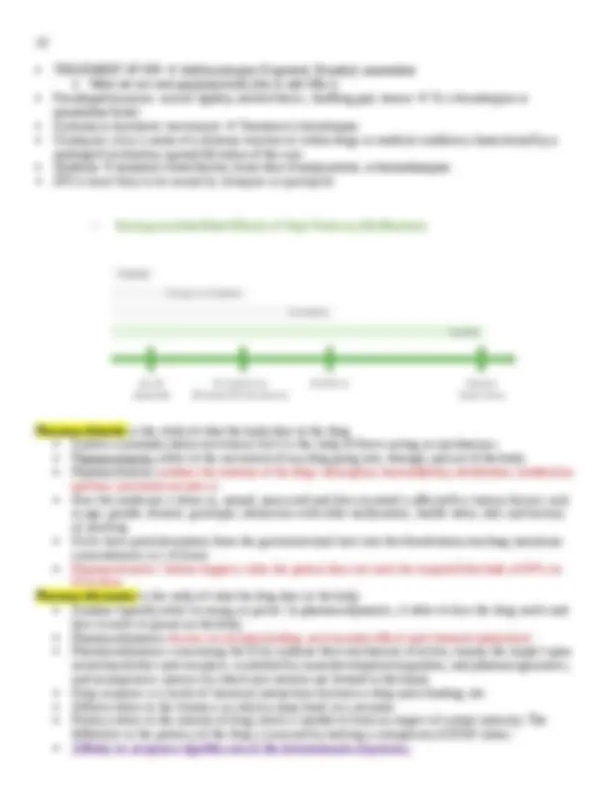
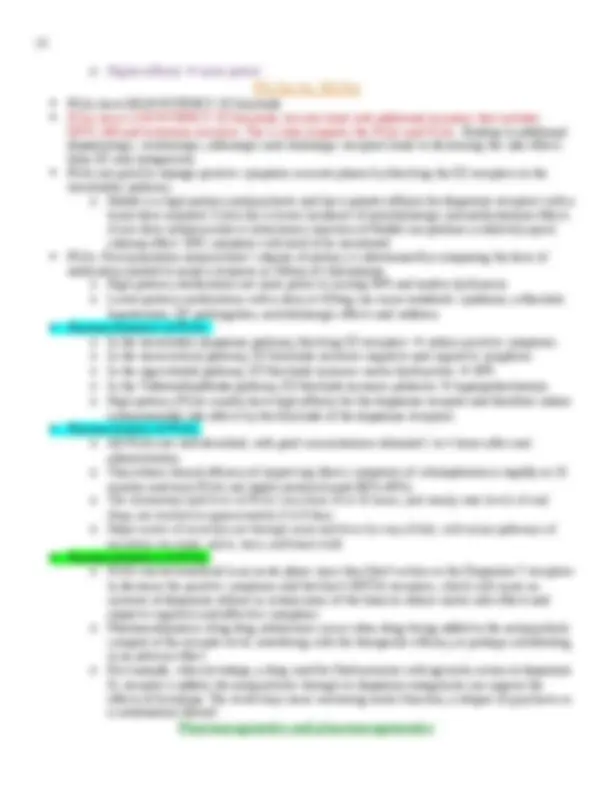
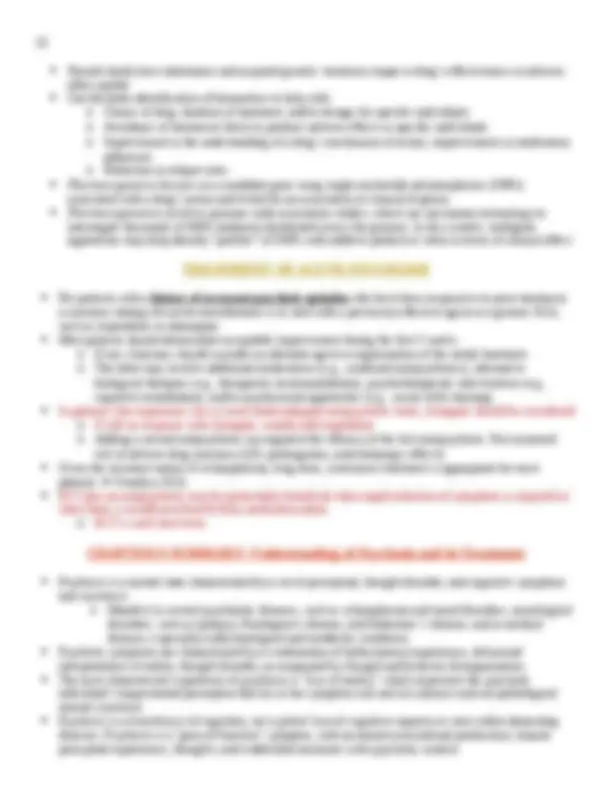
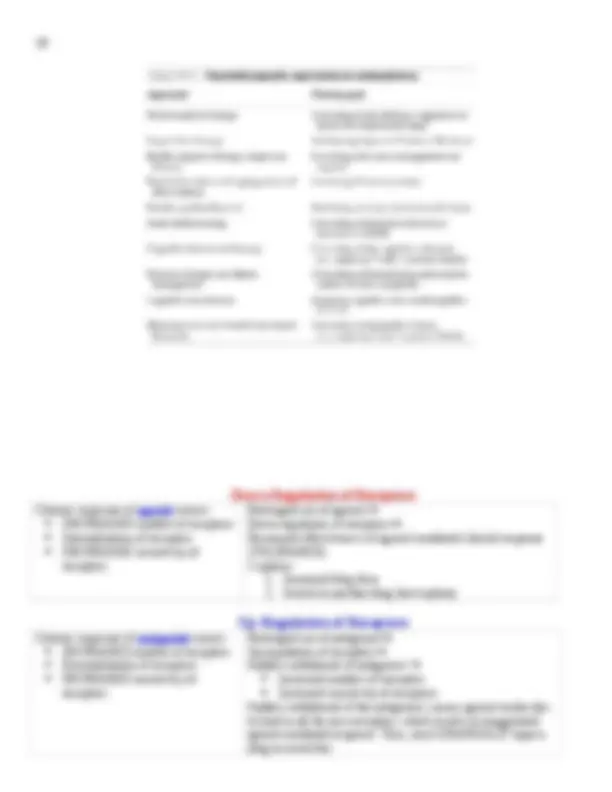
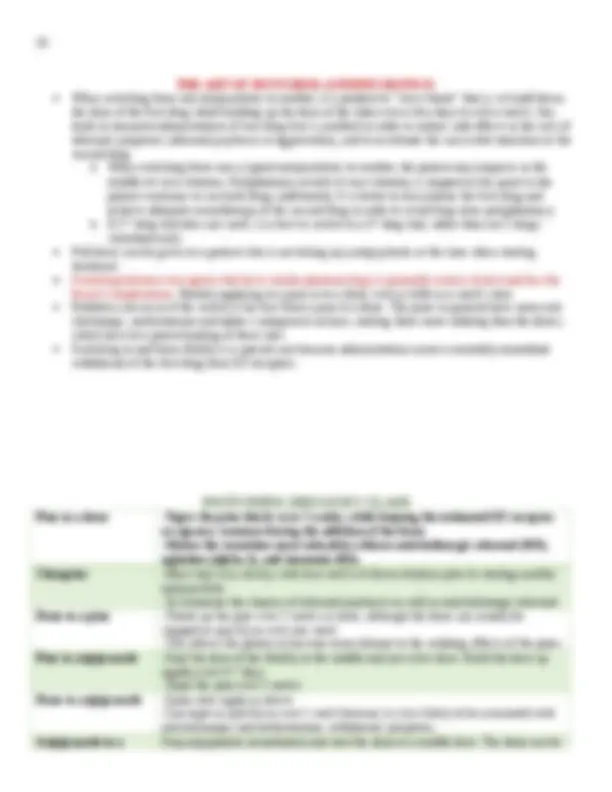
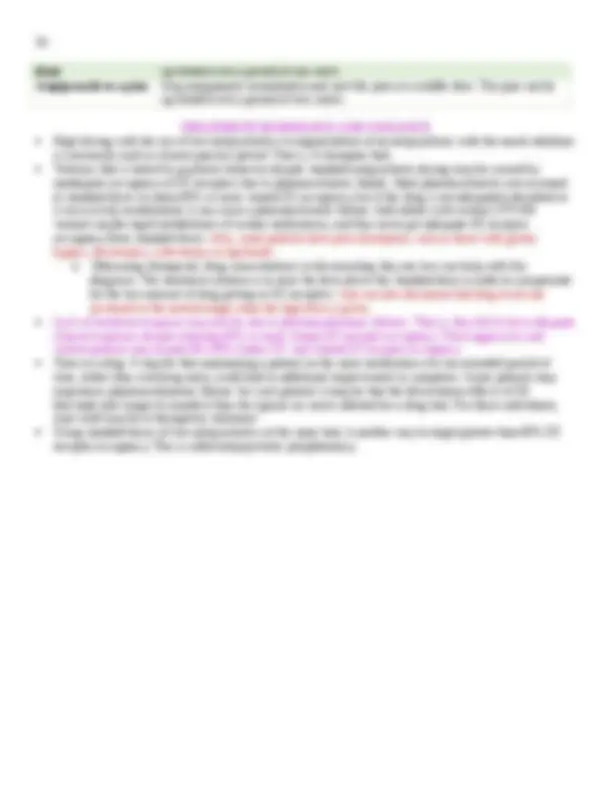
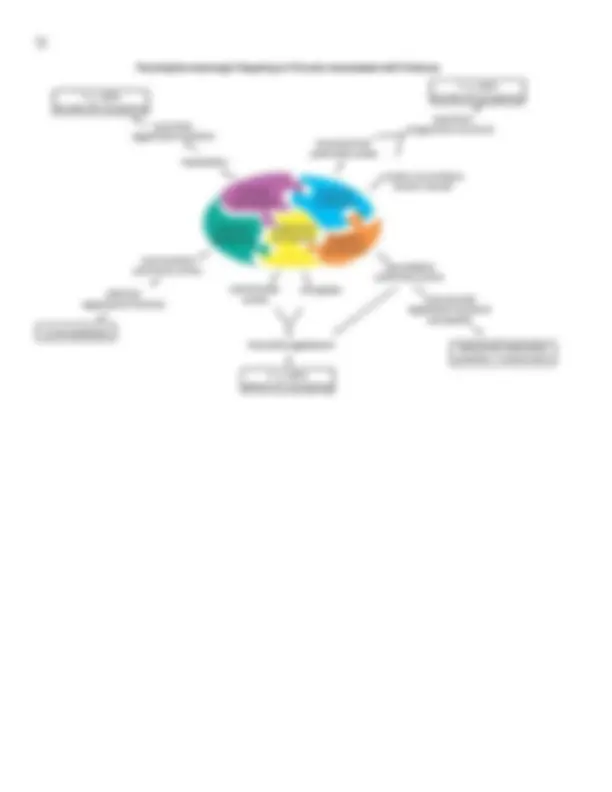


Study with the several resources on Docsity

Earn points by helping other students or get them with a premium plan


Prepare for your exams
Study with the several resources on Docsity

Earn points to download
Earn points by helping other students or get them with a premium plan
Community
Ask the community for help and clear up your study doubts
Discover the best universities in your country according to Docsity users
Free resources
Download our free guides on studying techniques, anxiety management strategies, and thesis advice from Docsity tutors
NSG552 / NSG 552 Exam 1 Study Guide (Latest 2025 / 2026): Psychopharmacology | Grade A | 100% Correct – Wilkes
Typology: Exams
1 / 21

This page cannot be seen from the preview
Don't miss anything!














Dopamine belongs to the family of catecholamines. It is a neurotransmitter.
Hormones, Epinephrine and Norepinephrine (other catecholamines) are derived from Dopamine
Dopamine plays a significant role in learning, goal-directed behavior, regulation of hormones, motor
control.
Phenylalanine (amino acid from diet) -> phenyalanine hydroxylase -> Tyrosine -> Tyrosine hydroxylase ->
DOPA -> Dopa decarboxylase -> Dopamine
KEY POINT: Dopamine is synthesized directly from tyrosine or indirectly from phenylalanine
Dopamine is packed and stored into synaptic vesicles via the vesicular monoamine transporter (VMAT2)
and stored until its release into the synapse.
When dopamine is released during neurotransmission, it acts on 5 types of postsynaptic receptors (D1-D5).
A negative feedback mechanism exists through the presynaptic D2 receptor which regulates the release of
dopamine from the presynaptic neuron.
Any excess dopamine is cleared out
o Presynaptically by Dopamine transporter (DAT)
o VMAT2 will take excess DA and store it in the synaptic vesicles for future neurotransmission
Excess dopamine is broken down within the presynaptic neuron by monoamine oxidase A (MAO-A), MAO-
B and extracellularly (outside the neuron) by catechol-o methyltransferase (COMT).
All antipsychotic drugs can reduce dopaminergic neurotransmission.
Dopamine neurotransmission is perpetuated via G protein-coupled receptors categorized into two broader
subtypes
1
o Includes subtypes D 1 and D 5
o Activation is coupled to G s ; activates adenylyl cylcase which leads to increase in concentration of
cAMP
2
o Includes D 2
3 and D 4
o Activation is coupled to G i ; inhibits adenylyl cyclase leading to decrease in concentration of cAMP
o Also open K channels & closes Ca influx
DAT (dopamine transporter) and VMAT2 are DA receptors that also regulate DA neurotransmission
Presynaptic D2 autoreceptors are “gatekeepers” and provide negative feedback input. When D2 receptors are
NOT bound to DA DA release. When D2 receptors bind to DA inhibit DA release
o Location: Striatum, substantia nigra, pituitary
o Located presynaptic and postsynaptic
Mesolimbic pathway: involved in pleasure and reward. Blocking D2 in this pathway by FGA’s not only
treats positive symptoms, but it blocks the reward mechanism and can cause apathy, lack of motivation, lack
of interest and the ability to feel joyful
Negative symptoms of psychosis are due to low dopamine in the mesocortical pathway. When FGA’s block
D2 receptors here, negative symptoms such as blunted affect, lack of pleasure, reduced social interaction
can worse
Dopamine inhibits prolactin release in the tuberoinfundibular pathway. When FGA’s bind to D2 in this
pathway, there is an increase in serum prolactin levels leading to galactorrhea, infertility or low sex drive.
The degree of D2 receptor binding in the mesolimbic pathway needed for antipsychotic effects is close to
80% , while D2 receptor occupancy greater than 80% in the dorsal striatum is associated with EPS and in
the pituitary is associated with hyperprolactinemia. This creates a very narrow therapeutic window Between
the threshold for antipsychotic efficacy and that for side effects in terms of a D2 binding.
If D2 receptors in the nigrostriatal DA pathway are blocked chronically, it can cause TD. D2 receptors are
hypothesized to become super sensitive or to upregulate (i.e.increase in number) perhaps in an attempt to
overcome drug induced blockade of D2 receptors in the striatum. After long term treatment the D2 receptors
apparently cannot or do not reset back to normal even when conventional antipsychotics are discontinued.
This leads to tardive dyskinesia that is irreversible, continuing whether conventional antipsychotic drugs are
administered or not
In addition to binding to D2 in all pathways, FGA’s also block muscarinic M1 cholinergic receptors, leading
to blurry vision, dry mouth, constipation and cognitive blunting (Stahl, p.138). FGAs that caused more EPS
are the agents that have weak anti cholinergic properties, whereas those FGAs that cause fewer EPS are the
agents that have stronger anti cholinergic properties. Dopamine normally inhibits acetylcholine. If dopamine
can no longer suppress acetylcholine release then acetylcholine becomes overly active. Therefore, EPS is a
result of dopamine deficiency and excess acetylcholine. Drugs with anticholinergic actions will diminish the
excess acetylcholine activity caused by removal of dopamine inhibition when dopamine receptors are
blocked by FGAs. Thus, EPS is reduced. This occurs in the nigrostriatal dopamine pathway.
The use of anticholinergic drugs with an FGA does not lessen the ability of the FGA to cause tardive
dyskinesia.
Other properties of FGA’s is the blockade of histamine receptors which leads to weight gain and drowsiness
(Stahl, 2013). Blockade of alpha1 receptors can have cardiovascular effects, such as hypotension and
drowsiness.
An old-fashioned way to sub classify FGAs is low potency versus high potency. Low potency agents tend to
have more of the additional properties such as blockade of muscarinic M1-cholinergic receptor, blockade of
histamine and alpha1-adrenergic receptors.
Serotonin also known as 5- hydroxytryptamine (5HT) is produced from enzymes after the amino acid
precursor tryptophan is transported into the serotonin neuron. Tryptophan is converted by the enzyme
tryptophan hydroxylase (TRY-OH) into 5-hydroxytryptophan, which is then converted into 5HT by the
enzyme, aromatic amino acid decarboxylase (AAADC).
Serotonin is then taken up into synaptic vesicles via the vesicular monoamine transporter (VMAT2), where
it stays until released by a neuron impulse. The 5HT neuron also has a presynaptic transport pump for
serotonin called the serotonin transporter (SERT) that terminates serotonin's actions by pumping it out of the
synapse and back into the presynaptic nerve terminal where it can be restored in synaptic vesicles for
subsequent use.
Second generation antipsychotics are a class defined as serotonin- dopamine antagonists. They have an
affinity of blocking serotonin and D2 receptors. SGA's almost always have higher affinity for 5HT2A
receptors than they do for D2 receptors (p.154).
o Other actions include partial agonism at 5HT1A receptors and partial agonist at D2 receptors.
SGA’s are different in that they bind to both D2 and serotonin receptors in the nigrostriatal pathway.
Therapeutic window: The 5HT2A and 5HT1A properties of SGA's lower the amount of D2 blockade in the
dorsal striatum (nigrostriatal) and in the pituitary to 60%. D2 receptor occupancy remains to be up to 80% in
the limbic area (nucleus accumbens).
5HT2A stimulation of cortical pyramidal neurons normally block downstream dopamine release in the
striatum. It does this via stimulation of glutamate release in the brainstem that triggers release of inhibitory
Has pro cognitive and antidepressant actions. Fluoxetine has 5HT2C antagonist properties it is often used
to boost olanzapine's antidepressant actions in treatment resistant and bipolar depression.
-All of the “pines” bind more potently to 5HT2C receptors than D2 – esp. clozapine & seroquel
5HT 3 receptors: Postsynaptic, regulate inhibitory GABA interneurons in various brain areas. Peripheral 5HT 3
receptors in the gut regulate bowel motility.
-Blocking 5HT3 receptors in the chemoreceptor trigger zone of the brain stem is an established
treatment for N/V caused by chemotherapy.
-Blocking this receptor on GABA interneurons increases the release of serotonin, dopamine,
norepinephrine, acetylcholine, and histamine in the cortex. This is a new approach to an
antidepressant and to a pro-cognitive agent. Only clozapine has 5HT 3 binding potency comparable to its D
binding potency period
5HT 6 receptors: Postsynaptic, decrease in inhibitory GABA allows for increases in the release of
acetylcholine and glutamate. Blocking this receptor improves learning and memory. Proposed as a new pro-
cognitive agent for the cognitive symptoms of schizophrenia when added onto an SGA. Potent 5HT 6
antagonists include clozapine, olanzapine, and asenapine.
5HT 7 receptors: Postsynaptic, regulator of serotonin release. When blocked, serotonin release is disinhibited.
5HT 7 selective antagonists are thought to be regulators of circadian rhythm, sleep, and mood. Several of the
“pines” and “dones” are potent 5HT 7 antagonists relative to D2 binding (clozapine, quetiapine, asenapine,
risperidone, paliperidone, and lurasidone).
D2 partial agonism: partial agonists at D2 receptors stabilize dopamine neurotransmission in a state between
silent antagonism and full agonism. They bind to 2 receptors that is neither too antagonizing (too cold, no
psychosis, but cases EPS) like a conventional antipsychotic, nor too stimulating like a stimulant or dopamine
itself (too hot, excess of full agonist, like DA, causes psychosis and N/V). It binds in an intermediary manner.
Partial agonists are sometimes called “Goldilocks” if they get the balance “just right” between full agonism and
complete antagonism, which results in NO psychosis and NO EPS. A very slight degree of partial agonist
property is sometimes called intrinsic activity. D2 partial agonism can make an antipsychotic atypical.
Serotonin and/or Norepinephrine reuptake inhibition : only Seroquel has potency greater than its D2 binding
Alpha-2 antagonism: Increases NE. several atypical antipsychotics have this action with variable degrees of
potency. All the “pines” (higher potency for clozapine and quetiapine) and “dones” (higher potency for
risperidone) and aripiprazole. Antidepressant effect (mirtazapine is a alpha-2 blocker).
Antimanic actions: All antipsychotics are effective for psychotic mania, but not for nonpsychotic mania. This
is due to D2 antagonism/partial agonism combined with 5HT2A antagonism.
Anxiolytic actions: Atypical antipsychotic use is controversial for the treatment of anxiety disorders, especially
PTSD. Quetiapine has the most evidence for use in anxiety disorders.
Sedative-hypnotic and sedating actions: sedation is both good and bad. Good for short-term treatment,
especially in early treatment during hospitalization, and when patients are aggressive, agitated or needing sleep
induction. Sedation is bad for long-term treatment because diminished arousal, sedation and somnolence can
lead to cognitive impairment, which compromises functional outcomes.
- M1 muscarinic cholinergic receptors, H1 histamine receptors, and alpha-1 adrenergic receptors
are responsible for causing sedation.
-The pines are more sedating than dones
-Lurasidone does not bind to H1 or muscarinic receptors
-The “rips and a pip” do not bind to muscarinic receptors
Evidence suggests that the best long-term outcomes in schizophrenia result when D2/5HT2A/5HT1A receptor
occupancy improves positive symptoms of psychosis, rather than from nonspecific sedation resulting from
alpha1, M1 and H1 receptor blockade.
Cardiometabolic actions
-All atypical antipsychotics share a class warning for causing risks for obesity, dyslipidemia, diabetes,
accelerated cardiovascular disease, and even premature death. H1 receptor and 5HT2C receptor blockade is
associated with weight gain.
Highest metabolic risk: clozapine, olanzapine
Moderate metabolic risk: risperidone, paliperidone, quetiapine, ilioperidone (weight only)
Low metabolic risk: ziprasidone, aripiprazole, lurasidone, ilioperidone
-The metabolic highway has three key stages. First, increased appetite and weight gain can lead to elevated
BMI, and ultimately obesity. Second, SGAs can cause insulin resistance by an unknown mechanism which can
be detected by measuring fasting plasma triglyceride levels. Finally, SGAs can cause sudden onset of diabetic
ketoacidosis or hyper glycemic hyperosmolar syndrome by unknown mechanisms, possibly including blockade
of M3 cholinergic receptors. If BMI or fasting triglycerides increased significantly, switched to a different
antipsychotic that has low metabolic risk.
-The metabolic toolkit includes four parameters: weight, fasting triglycerides, fasting glucose, and BP.
Unmanageable factors that may cause insulin resistance includes genetic makeup and age, while modestly
manageable include lifestyle (diet, exercise, and smoking).
Presynaptic dopamine dysfunction results in increased availability and release of dopamine and this has been
shown to be associated with prodromal symptoms of schizophrenia.
Schizophrenia is charactered by positive, negative, cognitive, affective and aggressive symptoms
Symptom Characteristics Pathway
Positive
symptoms
delusional thoughts, auditory and visual hallucinations,
disorganized speech (i.e. “word salad), agitation,
disorganized behavior, catatonic (loss of movement and
communication; confusion, restlessness)
Mesolimbic pathway
VTA nucleus accumbens
Negative
symptoms
flat affect, anhedonia, apathy, asociality (social isolation),
avolition (dysfunction of motivation; i.e. poor hygiene), poor
memory, impaired attention, stereotyped thinking, alogia
(dysfunction of communication; poverty of speech)
Mesocortical and some
mesolimbic pathway (nucleus
accumbens is part of the brain’s
reward circuitry, thus plays a role
in motivation)
Cognitive
symptoms
overall executive dysfunction. Problems maintaining goals,
allocational attentional resources, impaired attention,
prioritizing, serial learning, verbal fluency, problem solving.
Single strongest correlate of real-world functioning (Stahl, p.
Mesocortical pathway
(dorsolateral prefrontal cortex)
Aggressive
symptoms
related to impulse control. Overt hostility, verbal or physical
abusiveness, self-injurious behaviors, assault, arson or
property damage, and sexual acting out (Stahl, p. 85)
Located in the orbitofrontal
cortex and amygdala
Affective depressed mood, anxious mood, guilt, tension, irritability, and Mesocortical pathway
Mesolimbic
pathway
Malfunction
causes positive
symptoms
ventral tegmental
area (VTA) to the
nucleus
accumbens in the
ventral striatum
Nucleus accumbens
is part of the brain’s
reward circuit
-Site of the rewards
pathway
-Mediates pleasure,
motivation and
reward, emotion
-Goal directed
behavior
Excess dopamine
causes of positive
symptoms of
schizophrenia.
D2 antagonists
reduce positive
symptoms of
schizophrenia.
-65% occupancy
requirement is the
minimum threshold
for treatment to be
effective.
Mesocortical
pathway
Malfunction causes
negative symptoms
VTA to the
prefrontal cortex
-Negative and
cognitive symptoms
(dorsolateral PFC)
-Negative and
affective symptoms:
emotion and affect
(ventromedial PFC)
Decreased
dopamine causes
negative, cognitive
and depressive
symptoms of
schizophrenia.
D2 blockade
worsens the negative
symptoms of
schizophrenia
Nigrostriatal
pathway
EPS and TD
Substantia nigra
(brainstem) to the
basal ganglia or
striatum (caudate
and putamen).
Motor function and
movement
Decreased
dopamine in the
nigrostriatal
pathway caused by
antipsychotics
cause EPS
(dystonia,
parkinsonian
symptoms and
akathisia).
When DA is in
excess, it can cause
hyperkinetic
movements like tics
and dyskinesias.
Contains about 80%
of the brain’s
dopamine.
Long-standing D
blockade in the
nigrostriatal pathway
can lead to TD
TD is potentially
permanent
Tuderoinfundibular
pathway
Hyper-
prolactinemia
hypothalamus
(arcuate and
periventricular
nuclei) to the
anterior pituitary
Control prolactin
release.
Dopamine release
in the TI pathway
inhibits prolactin
release
D2 antagonism of
the TI pathway by
drugs such as
antipsychotics
causes
hyperprolactinemia
st
FGAs are either low or high potency drugs based on their affinity for D2 receptors - influences side
effects.
Low potency higher risk of metabolic side effects. High potency higher risk of EPS.
Metabolism: by the following three of the CYP450 enzymes, such as CYP1A2, CYP2D6 and
Elimination t1/2 is variable (18-30 hr).
Before starting patient on FGA: AIMS, VS, possible ECG
FGAs are contraindicated in patients with narrow angle glaucoma, seizure disorder, prostatic
hypertrophy, severe cardiac issues, and those who use benzodiazepines or barbiturates.
Drug Mechanism of action Toxicity
Phenothiazines:
-chlorpromazine
-prochlorperazine
-thioridazine
-fluphenazine
-trifluophenazine
Thioxanthenes
- thiothixene
-flupenthixol
-chlorprothixene
-clopenthixol
Blockade of D
Also blocker of alpha1,
Muscarinic, and H1 receptor.
Akathisia (severe restless movements)
Parkinson symptoms (including tremor, rigidity,
impaired gait, and bradykinesia (psychomotor
retardation)
Dystonia - involuntary muscle
spasms usually in the neck, jaw, or arms
Tardive dyskinesia - abnormal movements are usually
slow (I.e., Lip smacking, tongue thrusts, eye blinking)
or rapid jerks, twitching or writhing movements;
commonly manifest in the mouth, face, jaw, tongue,
hands, or feet.
Hyperprolactinemia - infertility, irregular menses,
loss of libido, galactorrhea, mastodynia, ED,
headaches, diplopia. Risperidone, paliperidone, and
haloperidol are the most common agents implicated.
Butyrophenones
-Haloperidol
-Droperidol
-Domperidone
Blockade of D
Alpha and minimal
muscarinic blockade
EPS dysfunction
Alpha1 blockade = can cause orthostatic hypotension and dizziness – peripherally. Causes sedation
centrally
H1 blockade = sedation and weight gain
Muscarinic blockade (anticholinergic) = Adverse effects can be peripheral (e.g., blurred vision, dryness
of mouth, urinary retention, constipation) or central (e.g., delirium, impaired working memory).
Common in low-potency FGAs (e.g., chlorpromazine, thioridazine) and certain SGAs (e.g., clozapine
and olanzapine).
Postsynaptic blockade of the D-2 receptor is known as primary mechanism of action of the first-
generation antipsychotics. They downgrade dopaminergic neurotransmission in dopamine paths
Parenteral (intramuscular) administration increases the bioavailability of active drug four- to tenfold.
Most antipsychotic drugs are highly lipophilic, highly membrane- or protein-bound, and accumulate in the
brain, lung, and other tissues with a rich blood supply.
They also enter the fetal circulation and breast milk.
Tolerance to the sedative and hypotensive action develops within day or weeks
nd
Before starting patient on SGAs: weight, BMI, fasting glucose and lipids, BP, EKG
o Recheck weight and BMI at 4, 8, 12 weeks, 6 months, quarterly and annually follow up
o Fasting glucose and lipids repeated only at 6 months and annually
If metabolic syndrome does occur switch agents, lower dose if possible or add metformin
SGAs differ from the FGAs by their action on transiently occupying D2 receptors. After binding to
the D2 receptors, the drugs dissociate rapidly to allow dopamine neurotransmission.
SGAs have serotonin 5HT2A antagonism and 5HT1A agonism
Common side effects: Metabolic syndrome (weight gain, insulin resistance, elevated lipids), Lower
seizure threshold, QT prolongation
twice daily dosing
Asenapine
7
1B/D antagonism
partial agonism
antagonism
, and α 2
antagonism
-Given sublingually.
Cannot eat or drink
for 10 mins after
taking it
-rapidly absorbed SL
with rapid peak drug
levels.
-Given BID despite
long half-life
-used as a rapid-acting oral PRN
antipsychotic to “top up” some
psychotic patients rapidly without
resorting to an injection.
-May improve depression due to
5HT2C antagonism
-Side effects: oral hypoesthesia when
given SL, sedation, dizziness, akathisia,
-TD is rare
Cariprazine
At very low
doses, D 3
preferring
over D 2
affinity
partial agonist
Potent 5HT 1A
partial
agonist and 5HT 2B
-Moderate
antagonism
At higher doses, 5HT 7
and
antagonism - give
it antidepressant actions.
Metabolized by
CYP450 3A4 into
two long- lasting
active metabolites
half- life for
cariprazine is 2–
days and for other
metabolite - DDCAR
its 1–3 weeks
little weight gain, metabolic problems
and EPS
Other SE: akathisia , sedation, GI sx
receptors is largely unknown but
may be linked to cognition, mood,
emotions, and reward/substance abuse.
Aripiprazole
Used in 1
st
line for SZ in
adolescents
D2 partial agonist and 5-
1A receptor
Blockade of alpha 1
Blockade of 5HT2C and 7
receptors as well as partial
agonist actions at 5HT1A
receptors may contribute
to antidepressant actions
Metabolized by
CYP2D6 and
Very long half-life
t1/2 75-100 hrs)
Takes longer to reach
steady state when
initiating dosing, and
longer to wash out
when stopping
dosing, than other
APDs
Available in LAI 4-,
6-, 8- weeks
Common SE: insomnia, nausea,
vomiting, akathisia , constipation,
dizziness and orthostatic hypotension,
occasionally during initial dosing
Rare SE: hyperprolactinemia,
hypotension and QT prolongation
Risperidone Blockade of 5HT2A and
high affinity for α 1 , α 2 and
H1 receptors
Metabolized by
PO: 20–24 hour half-
life
IM: 7–8 weeks half
life after last injection
LAI q 2 weeks
-More potent D2 blocker than
clozapine; extrapyramidal side effects
are less only at low doses ( <6 mg/
day).
-Most common SGA to increase
prolactin
-Less epileptogenic than clozapine
in the elderly.
Paliperidone Blockade of 5HT2A and
not hepatically
metabolized ; its
more tolerable, with less sedation, less
orthostasis, and fewer EPS than
*the active
metabolite of
risperidone
elimination is via
urinary excretion
PO form is daily in
sustained release
form
Available in LAI q 4
wks
Half-life 23 hours
risperidone
Dosing and titration are not the same as
risperidone. Usually start at 6 mg daily
as opposed to 3 mg with risperidone
Side effects: Weight gain, insulin
resistance, diabetes, increase in
prolactin, hypersalivation
Ziprasidone
Favored in
the early
stages of
illness
because of
its mild side-
effect
profile.
Blockade of 5HT2A and
Blocks alpha 1 receptors
2C antagonism and
1A partial agonism
contribute to efficacy for
cognitive and affective
symptoms
Interactions at 5HT 1 B/D
and 5HT7 receptors and at
serotonin and
norepinephrine
transporters may treat
affective symptoms
Must be given BID
due to short half life
Metabolized by CYP
Absorption is
increased if given
with food
High risk of QT prolongation
Rare risk of rash: Drug Reaction with
Eosinophilia (DRESS). DRESS may
begin as a rash but can progress to
others parts of the body and can include
symptoms such as fever, swollen lymph
nodes, swollen face, inflammation of
organs, and an increase in white blood
cells known as eosinophilia. In some
cases, DRESS can lead to death.
Common SE: Activation (at very low
to low doses), dizziness, sedation
(dose-dependent), dystonia at high
doses, nausea, dry mouth (dose-
dependent), Asthenia, orthostatic
hypotension
Ilioperidone Blockade of serotonin
5HT2A and D
potent α 1
antagonism
-Dosed BID and
titrated over several
days when initiated to
avoid orthostasis and
sedation.
-Available in LAI
q4wks
-Very low level of EPS due to potent α 1
and
5HT2A antagonism like clozapine
and quetiapine
-Low level of dyslipidemia
-Moderate weight gain
-QTc prolongation at high doses
Lurasidone Blockade of serotonin
5HT2A and D
High affinity for 5HT 7
and 5HT 2A
receptors
Moderate affinity for
and α 2
receptors
minimal affinity for H 1
and M 1
binds most potently to the
Absorption is
increased if given
with food
-Little sedation, weight gain,
dyslipidemia
-Moderate EPS, but this is reduced if
given at night
-No QTc prolongation
7 antagnosim (increases SE)
, and α 2
receptors suggests why
this drug has antidepressant efficacy.
TREATMENT OF EPS Add benztropine [Cogentin], Benadryl, amantadine
o Meds are not used prophylactically due to side effects
Pseudoparkinsonism: muscle rigidity, masked facies, shuffling gait, tremor Tx is benztropine or
amantadine better
Dystonia or dyskinetic movements Treatment is benztropine
Oculogyric crisis is name of a dystonic reaction to certain drugs or medical conditions characterized by a
prolonged involuntary upward deviation of the eyes.
Akathisia treatment is beta blocker, lower dose of antipsychotic, or benzodiazepine
EPS is least likely to be caused by clozapine or quetiapine
Pharmacokinetics is the study of what the body does to the drug
Kinetics essentially means movement, but it is the study of forces acting on mechanisms.
Pharmacokinetics refers to the movement of any drug going into, through, and out of the body.
Pharmacokinetics outlines the timeline of the drug’s absorption, bioavailability, distribution, metabolism
and how your body excretes it.
How the medicine is taken in, spread, processed and also excreted is affected by various factors such
as age, gender, disease, genotype, interaction with other medications, health status, diet, and history
of smoking
SGAs have good absorption from the gastrointestinal tract into the bloodstream reaching maximum
concentrations in 1–6 hours
Pharmacokinetics' failure happens when the patient does not meet the required blockade of 60% on
SGA dose.
Pharmacodynamics is the study of what the drug does to the body.
Dynamo typically refers to energy or power. In pharmacodynamics, it refers to how the drug works and
how it exerts its power on the body.
Pharmacodynamics focuses on receptor binding, post-receptor effects and chemical interactions.
Pharmacodynamics concerning the SGA combine their mechanism of action, mainly the impact upon
neurotransmitters and receptors, controlled by neurodevelopment/migration, and pharmacogenomics,
and neurogenesis (process by which new neurons are formed in the brain).
Drug response is a result of chemical interactions between a drug and a binding site.
Affinity refers to the firmness in which a drug binds to a receptor.
Potency refers to the amount of drug which is needed to form an impact of certain intensity. The
difference in the potency of the drug is assessed by making a comparison of ES50 values.
Affinity to receptors signifies one of the determinants of potency.
o Higher affinity more potent
FGAs have HIGH POTENCY D2 blockade
SGAs have LOW POTENCY D2 blockade, but also bind with additional receptors that includes
5HT2, M3 and histamine receptors. The is what separates the FGAs and SGAs. Binding to additional
dopaminergic, serotonergic, adrenergic and cholinergic receptors leads to decreasing the side effects
from D2 only antagonism.
FGAs are good to manage positive symptoms in acute phases by blocking the D2 receptors in the
mesolimbic pathway.
o Haldol is a high potency antipsychotic and has a greater affinity for dopamine receptors with a
lower dose required. It also has a lower incidence of anticholinergic and antihistamine effects.
A low dose intramuscular or intravenous injection of Haldol can produce a relatively quick
calming effect. EPS symptoms will need to be monitored.
FGAs: First generation antipsychotic’s degree of potency is determined by comparing the dose of
medication needed to equal a response at 100mg of chlorprazine.
o High potency medications are more prone to causing EPS and tardive dyskinesia.
o Lower potency medications with a dose at 100mg can cause metabolic syndrome, orthostatic
hypotension, QT prolongation, anticholinergic effects and sedation.
Pharmacodynamics of FGAs:
o In the mesolimbic dopamine pathway, blocking D2 receptors reduce positive symptoms.
o In the mesocortical pathway, D2 blockade increases negative and cognitive symptoms
o In the nigrostriatal pathway, D2 blockade increases motor dysfunction EPS
o In the Tuderoinfundibular pathway, D2 blockade increases prolactin hyperprolactinemia
o High potency FGAs usually have high affinity for the dopamine receptor and therefore induce
extrapyramidal side effects by the blockade of the dopamine receptors.
Pharmacokinetics of FGAs:
o All FGAs are well absorbed, with peak concentrations obtained 1 to 4 hours after oral
administration.
o They attain clinical efficacy of improving illness symptoms of schizophrenia as rapidly as 15
minutes and most FGAs are highly protein bound (85%-90%).
o The elimination half-lives of FGAs vary from 18 to 40 hours, and steady-state levels of oral
drugs are reached in approximately 3 to 8 days.
o Major routes of excretion are through urine and feces by way of bile, with minor pathways of
excretion via sweat, saliva, tears, and breast milk
Pharmacodynamics of SGAs:
o SGAs can be beneficial in an acute phase since they block action on the Dopamine 2 receptors
to decrease the positive symptoms and the block 5HT2A receptors, which will cause an
increase of dopamine release in certain areas of the brain to reduce motor side effects and
improve cognitive and affective symptoms
o Pharmacodynamics drug-drug interactions occur when drugs being added to the antipsychotic
compete at the receptor level, interfering with the therapeutic efficacy or perhaps contributing
to an adverse effect.
o For example, when levodopa, a drug used for Parkinsonism with agonistic action at dopamine
2 receptor is added, the antipsychotic through its dopamine antagonism can oppose the
effects of levodopa. The result may cause worsening motor function, a relapse of psychosis or
a combination thereof.
Psychosis is a broadly expressed symptom set across many diagnoses
Schizophrenia is one of the more severe psychotic disorders.
o In addition to the psychosis, the cognitive dysfunctions are with attention, working and
declarative memory, and executive functions
o A negative symptom complex can be present and is characterized by reduced affect expression
and awareness, reduced social interactions, and thought and speech paucity
o SZ is not a disturbed mood state, as seen in depression, but rather a blunted or reduced mood
experience.
Caution ought to prevail around taking only the psychotic symptomatology into account in generating a
diagnosis without looking at the psychosis within the context of more characteristic mood and cognition
disease symptomatology.
Schizophrenia and psychosis are complex genetic illnesses. Genes that increase risk of psychosis, include:
o Brain-derived neurotrophic factor ( BDNF )
o Neuregulin 1 ( NRG1 )
o Disrupted in schizophrenia 1 ( DISC1 )
o Distroverin-binding protein (DTNBP1)
Several chromosomal regions show associations with both schizophrenia and affective psychosis.
Family studies have provided strong evidence for heritability and familial aggregation of schizophrenia and
other psychotic disorders. The lifetime risk for developing schizophrenia increases approximately 8- to 12-
fold in first-degree relatives of probands with schizophrenia.
o Proband: a person serving as the starting point for the genetic study of a family
Connection between abnormal learning and memory as mediated in hippocampus within medial temporal
cortex and psychotic symptoms.
People with schizophrenia have “global” deficits in declarative memory
o Declarative memory: functions like encoding, retrieval, and long-term storage, as well as
associative binding within and across memory episodes, memory consolidation, and subsequent
generalization to new episodes
o Deficits in the relational component of declarative memory , relational memory (RM). RM is the
make new associations across memory episodes for the purpose of applying information from
past experience to novel environments. Network of brain regions that subserve RM include
hippocampus and prefrontal cortex.
o RM may itself be a “biomarker” for the clinical phenotype of psychosis.
Psychosis is associated with increases in basal hippocampal activity (as measured by regional
cerebral perfusion) and reduced neural activation during RM processing
o Each of the hippocampal subfields (dentate gyrus [DG], cornu amonius 3 [CA3], cornu amonius
1 [CA1], and subiculum) functions in memory formation and are connected by a unidirectional
pathway that mediates normal and relational memory.
Psychosis is dependent on a pathological increase in the level of neuronal function in CA3, which exceeds
the associational capacity of this subfield and results in mistaken and false associations, some with
psychotic content, which then get consolidated into memory, albeit with psychotic content. These psychotic
memories utilize normal declarative memory pathways even though the memories have psychotic content.
The hippocampus contributes to memory formation by creating conjunctive representations, binding
multiple elements into a single memory representation, as well as memory consolidation
The neocortex provides a long-term memory source and cognitive control of memory formation
Hippocampal hyperperfusion is a new biomarker for marking psychosis. Treatment for psychosis
should seek to reduce neuronal activity in the hippocampus.
Phases of schizophrenia
personality changes, as well as subthreshold psychotic-like symptoms beginning insidiously over time.
insight.
treatment, comorbid depression and anxiety, and a tendency to frequent stress-induced relapse before
stabilization.
and remissions and exacerbations in psychotic symptoms.
Disturbances in affect
Abnormal reactivity of the amygdala along with prefrontal impairment may result in impaired emotion
recognition and expression (or flattening of affect).
By contrast, hyperactive dopamine systems in the context of a failure of prefrontal regulation may cause
increased autonomic arousal and aberrant emotional salience to nonthreatening stimuli, which are
characteristic of psychosis
When switching from one antipsychotic to another, it is prudent to “cross titrate” that is, to build down
the dose of the first drug while building up the dose of the other over a few days to a few weeks. this
leads to transient administration of two drugs but is justified in order to reduce side effects in the risk of
rebound symptoms (rebound psychosis or aggravation), and to accelerate the successful transition to the
second drug.
o When switching from one a typical antipsychotic to another, the patient may improve in the
middle of cross titration. Polypharmacy results if cross titration is stopped at this point in the
patient continues to use both drugs indefinitely. It is better to discontinue the first drug and
achieve adequate monotherapy of the second drug in order to avoid long-term polypharmacy.
o If 2
nd
drug trial does not work, it is best to switch to a 3
rd
drug trial, rather than use 2 drugs
simultaneously.
Full doses can be given to a patient who is not taking any antipsychotic at the time when starting
treatment
Switching between two agents that have similar pharmacology is generally easiest, fastest and has the
fewest complications. Namely applying to a pine or to a done, over as little as a week's time
Problems can occur if the switch is too fast from a pine to a done. The pines in general have more anti
cholinergic, antihistamine and alpha-1 antagonists actions, making them more sedating than the dones,
which have less potent binding at these sites.
Switching to and from Abilify is a special case because administration causes essentially immediate
withdrawal of the first drug from D2 receptors.
Pine to a done -Taper the pine slowly over 2 weeks, while keeping the estimated D2 receptor
occupancy constant during the addition of the done.
-Makes the transition more tolerable without anticholinergic rebound (M3),
agitation (alpha-1), and insomnia (H1).
Clozapine -Must stop very slowly, with four weeks of down-titration prior to starting another
antipsychotic.
-To minimize the chances of rebound psychosis as well as anticholinergic rebound.
Done to a pine -Titrate up the pine over 2 weeks or more, although the done can usually be
stopped as quickly as over one week.
-This allows the patient to become more tolerant to the sedating effects of the pines.
Pine to aripiprazole -Start the dose of the Abilify in the middle and not a low dose. Build the dose up
rapidly over 3-7 days.
-Taper the pine over 2 weeks.
Done to aripiprazole -Same rules apply as above
-Can taper as quickly as over 1 week because it is less likely to be associated with
anticholinergic and antihistaminic withdrawal symptoms.
Aripiprazole to a Stop aripiprazole immediately and start the done at a middle dose. The done can be
done up titrated over a period of one week
Aripiprazole to a pine Stop aripiprazole immediately and start the pine at a middle dose. The pine can be
up titrated over a period of two weeks
High dosing with the use of two antipsychotics or augmentation of an antipsychotic with the mood stabilizer
is commonly used in clinical practice period. That is, if clozapine fails.
Violence that is linked to psychotic behavior despite standard antipsychotic dosing may be caused by
inadequate occupancy of D2 receptors due to pharmacokinetic failure. Ideal pharmacokinetics are assumed
at standard doses to attain 60% or more striatal D2 occupancy, but if the drug is not adequately absorbed or
is excessively metabolized, it can cause a pharmacokinetic failure. Individuals with certain CYP 450
variants maybe rapid metabolizers of certain medications, and thus never get adequate D2 receptor
occupancy from standard doses. Also, some patients have poor absorption, such as those with gastric
bypass, ileostomies, colectomies or lap bands.
o Measuring therapeutic drug concentrations in documenting they are low can help with this
diagnosis. The treatment solution is to raise the dose above the standard dose in order to compensate
for the low amount of drug getting to D2 receptors. One can also document that drug levels are
increased in the normal range when the high dose is given.
Lack of treatment response may also be due to pharmacodynamic failures. That is, they fail to have adequate
clinical responses despite attaining 60% or more striatal D2 receptor occupancy. These aggressive and
violent patients may require 80-100% limbic D2 and striatal D2 receptor occupancy.
Time as a drug. It may be that maintaining a patient on the same medication over an extended period of
time, rather than switching early, could lead to additional improvement in symptoms. Some patients may
experience pharmacodynamic failure. for such patients it may be that the downstream effects of D
blockade take longer to manifest than the typical six weeks allotted for a drug trial. For these individuals,
time itself may be at therapeutic treatment
Using standard doses of two antipsychotics at the same time is another way to target greater than 60% D
receptor occupancy. This is called antipsychotic polypharmacy.